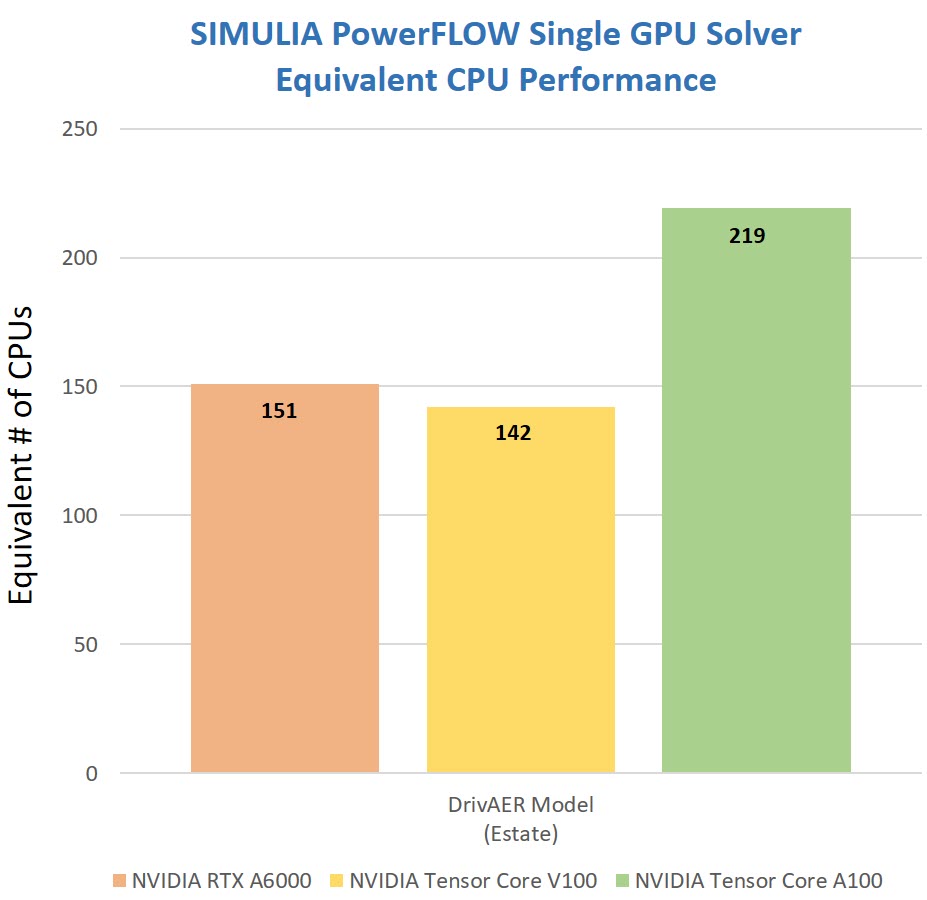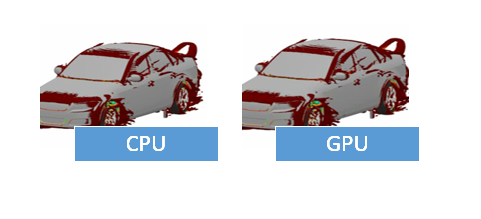SIMULIA PowerFLOW simulations bring powerful insight to designers and engineers when exploring their aerodynamic, aero-acoustic, and thermal problems. The need for speed in the design process has increased, with engineers needing to analyze the latest design iteration overnight, not next week. Deploying high-fidelity fluid simulation can require computing power which is outside the budgets of many product and engineering organizations. Most industrial scale problems need large HPC (high-performance computing) clusters to tackle their biggest problems. These competing demands have inspired the development of PowerFLOW GPU (graphics processing unit) solver.
The PowerFLOW GPU solver provides the same physics as the CPU (central processing unit) solution, but executable on NVIDIA GPUs. This allows users to run small-scale problems on a desktop equipped with a GPU, or to simulate industrial scale problems on multiple GPU systems. GPU computing reduces the expense of buying and maintaining a CPU HPC cluster, bringing PowerFLOW fluid simulation to component analysis and early concept design.

The PowerFLOW GPU solver is first available in the PowerFLOW 2022 release. This release allows for solving 3D, low-Mach, isothermal simulations on a single NVIDIA GPU, which enables concept and component designers to perform analysis on smaller scale problems. Future releases will allow for multi-GPU support, so that full industrial problems of the largest size can be solved on GPU based HPC systems.
The performance of the GPU solver will vary depending on what GPU is being used and what CPU it is being compared against, but generally, one NVIDIA A100 Tensor Core GPU will replace 120-200 CPU cores. The PowerFLOW GPU solver is licensed the same way as the PowerFLOW CPU solver: no special or additional licenses are necessary to use the solver.
The PowerFLOW GPU solver empowers designers to quickly analyze designs and iterate, rather than waiting for results, or needing to rely on other departments to provide analysis for them. This democratization of the simulation process allows vehicle designers and engineers, who previously did not have the resources necessary to run PowerFLOW simulations, to have access to those state-of-the-art features present in the PowerFLOW solver: automatic grid generation, proprietary VLES turbulence model, time-accurate transient results, and automated case-setup and post-processing.

Using the GPU solver and Concept Aerodynamic Design Best Practices, a designer should be able to rapidly prepare PowerFLOW simulation for a concept vehicle at the end of the work day, submit the simulation and get results overnight. The solution accurately captures transient aerodynamic interaction between different parts of the vehicle with high fidelity, enabling rapid evolution of the concept design.
The PowerFLOW team is excited to unlock the power of PowerFLOW simulation for more users in the concept design and component design space, while giving our existing users the possibility of expanding their GPU compute ability to include PowerFLOW. The PowerFLOW GPU solver along with our Design Best Practice and automation templates will allow designers without a background in simulation, numerics, or fluid dynamics to simulate and understand the aerodynamic impact of their designs, and operate independently of their simulation and analysis department to more quickly bring their designs to life.
Join a community of simulation enthusiasts focused on advancing the use of SIMULIA simulation solutions in science and engineering! It’s free and easy. Start a discussion with other members of the SIMULIA Community. Talk through your simulation questions with peers, SIMULIA experts, and SIMULIA Champions. Apply to be an author to create posts, share useful tips you discovered for SIMULIA software, and establish yourself as a thought-leader. The SIMULIA Community is home to both SIMULIA product users and SIMULIA subject matter experts around the world.

